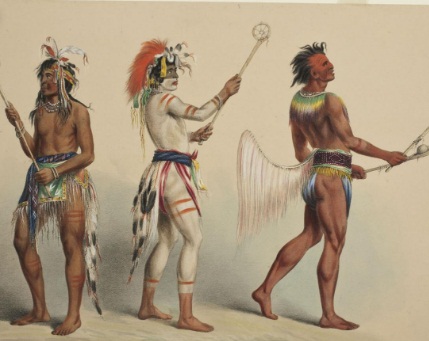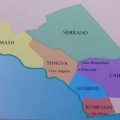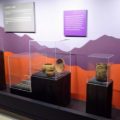All societies have government. At the time of the European invasion, American Indian cultures differed greatly from their European counterparts in the way in which they governed themselves and, as a result, many European writers believed that Indian nations did not have governments.

The government of European nations tended to be based on the peculiar notion that some men (and/or families) had been endowed by their god to rule over other people (i.e. the concepts of kingship and nobility). The Europeans expected Indians to have monarchs, rulers who could tell other people what to do. While this was true for some Indian cultures, most did not have royalty. Instead, Indian cultures tended to be democratic and most of the members of the society had a say in important decisions.
In general, cross-cultural studies suggest that communities with 500 or fewer individuals tend to be egalitarian without formal leadership roles. Most of the so-called “hunting and gathering” tribes would fall into this category.
While California had a relatively high population and a great diversity in languages and cultures, the Indian governments tended to be democratic in that the majority decided on the major issues which faced the tribes.
Sovereignty, Autonomy
The concept of the “tribe” was superimposed on the Native people of California by the United States as an administrative way of dealing with as few sovereign entities as possible. In reality, villages tended to be autonomous, politically sovereign units. Villages which shared a common language, religious customs, and ancestral heritage, which were considered to be tribes by the government and sometimes by anthropologists, maintained their own political autonomy.
Among the Tolowa in Northern California, for example, each village was autonomous and there was within the village no formal position of chief or* council. The village leader was usually a wealthy individual. Wealth was determined by ownership of chipped obsidian, redheaded woodpecker scalps, and dentalia (a kind of shell).
The Pomo, whose traditional homelands were located inland from the Pacific Ocean about 50 miles north of present-day San Francisco, were not a politically unified tribe, but were a group of villages which shared a common language.
“Chiefs”
In general, the concept of an “Indian chief” is really a European concept. Leadership among Indian cultures often tended to be based on the individual’s ability to get other people to listen and follow. Oratory was one of the key elements of leadership. In addition, leaders were often expected to be generous (they often were required to feed and house all visitors). Leadership was often informal.
A chief, often given the title “Captain” by non-Indians, had relatively little authority. They led by example and by the powers of their oratory. They were able to persuade other people, but they could not give orders. Chiefs could state tribal law and custom but could not pronounce judgment on anyone. In their book The Natural World of California Indians, Robert Heizer and Albert Elsasser write:
“Chiefs, who had no real power in most of native California beyond the offering of good advice in a persuasive manner, helped to keep life moving along with a minimum of friction.”
Among many California tribes, leadership was not always hereditary though chiefs were often from wealthy families and inherited the position because of family status. The leaders cared for the people by offering advice and making suggestions. With regard to economics, the chiefs often governed hunting and gathering on tribal lands and made sure that food and other goods were evenly distributed. One of the responsibilities of the chiefs was to see to it that the needy were fed and housed. Often the chief decided on the time for ceremonies and arranged for public feasting in conjunction with these ceremonies.
Among the Karuk, leadership was based on wealth. According to anthropologist Maureen Bell, in her book Karuk: The Upriver People:
“The wealthiest and most honorable individuals usually had good judgment, communal interest, and were dedicated to the values and laws of the group.”
While Pomo chiefs were usually hereditary, the chiefs had to prove themselves or public pressure would force them to resign. With regard to Pomo chiefs, Vinson Brown and Douglas Andrews, in their book The Pomo Indians of California and Their Neighbors. report:
“They had little direct power, such as giving orders, except sometimes in emergency, but many became clever diplomats, speakers, persuaders and users of astute psychology, so having great influence.”
The primary roles of the Pomo chief were to maintain peace, particularly when families or villages began quarreling, to organize expeditions for trade or food gathering, and to help with ceremonies.
Among the Wintu, leadership was traditionally based on respect and oratorical skills were extremely important. The leader of a Wintu village served as a master of ceremonies at social gatheringss. With regard to government, the leader would sum up what had been said in council meetings and put the village consensus into words. Village leaders were also involved in dealings with other villages and so it was also important that these leaders be multi-lingual.
Anthropologist Isabel Kelly, in her chapter in the Handbook of North American Indians, describes the transition from one chief to another among the Coast Miwok:
“The old chief and four elderly women tutored an incipient headman; and when the successor was ready to take over, the incumbent withdrew or a poisoner was hired to liquidate him.”
The Chumash chief – called wot – was a position which was inherited through the patrilineal line. The primary duties of the wot were caring for the elderly and the indigent. Larger Chumash communities, such as Syuhtun and Shisholop, had several wot whose duties included the assigning of hunting and gathering areas and making sure that supplies were set aside for special occasions, such as religious and social festivals.
Dual Chiefs
It was common for American Indian societies to have more than one leader. Among some tribes, there was a hunt leader, a war leader, a ceremonial leader, and so on. All of these leadership roles required different skills and there was no assumption that a single individual could fill all of these roles.
Among some California tribes, such as the Pomo and the Shasta, there were two chiefs: a war chief (called the “arrow man” among the Pomo) and a peace chief (called the “shell man” among the Pomo). The peace chief helped to settle disputes within the tribe and presided over ceremonial events. Among the Pomo, the peace chief was generally the best orator in the tribe.
Women Leaders
Among many of the California tribes, chiefs could be men or women. Among the Costanoan peoples and the Gabrielino, for example, the office of chief was inherited patrilineally and if there was no male heir, then the office would pass to a sister or a daughter. While Chumash leaders inherited their positions patrilineally—through the father—there were some instances in which daughters or sisters became chiefs.
Among some of the tribes, such as the Maidu and the Atsugewi, there were secondary female chiefs who supervised the preparation of food for feasts. Among the Maidu, the female sub-chiefs tended to be the chief’s daughters while among the Atsugewi they were the chief’s wives.
Messenger
Among many tribes, the chief would appoint a messenger. Messengers were generally selected on their ability to speak and their reliability. Messengers had to have good memories for they had to deliver lengthy and complicated messages accurately. With regard to memory, Malcolm Margolin, in his book The Way We Lived: California Indian Reminiscences, Stories and Songs, reports:
“It has been noted that Native Californians who had heard an important speech just one time could repeat it twenty years later, the renditions of various listeners being almost identical.”
Each Maidu village had six messengers, while among the Atsugewi the number of messengers varied.
Village Councils
In general, chiefs were assisted by a council of elders who attempted to reach consensus for decision-making.
Clowns
Among many California tribes, clowns were major ceremonial figures. The clown parodies the dancers and the master of ceremonies. While the clown projects a ridiculous figure, emphasizing gluttony, greed, foolishness, lasciviousness, they are at the same time spiritual figures who are protected by sacred powers. Atsugewi chiefs appointed clowns who performed at public ceremonies.



Leave a Reply